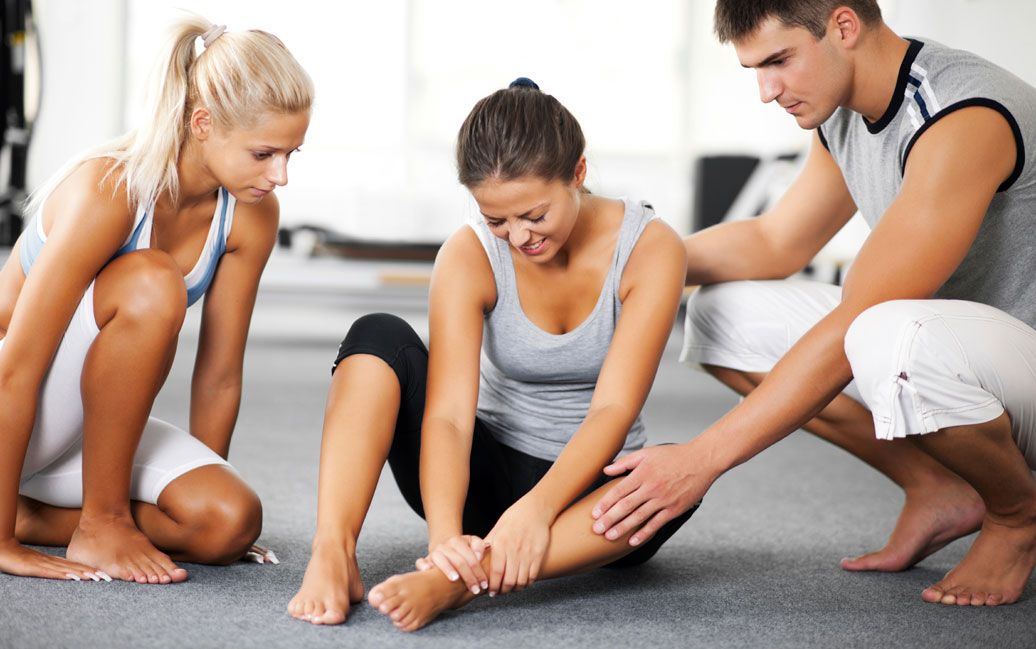

Muscle Strains and Tears
A strain or tear in a muscle occurs when some or all the fibres fail to cope with the demands placed upon them. Muscles commonly affected are hamstring (posterior thigh), quadriceps (anterior thigh) and gastrocnemius (calf muscle). This is typically because these muscles cross two joints and therefore are more susceptible to injury – hamstring injuries in particular are the single most common injury in AFL.
Strains/tears are often the result of sudden acceleration or deceleration – hamstring injuries commonly occur during sprinting or kicking movements, similarly, calf injuries commonly occur with sudden bursts of movement such as a jumping, hopping, or sudden change of direction.
When these injuries occur signs and symptoms include:
- Sudden onset and immediate pain
- Loss of strength/power
- Inability to weight bear on that leg – pain with walking, unable to run
- Localised bruising and swelling
- Localised tenderness
Sprains
Unlike strains where the muscle is damaged, sprains are injuries to ligaments where an overstretching or tear of the ligament tissue occurs. Ligaments attach bone to bone and consequently are a main stabiliser of joints. Signs and Symptoms for sprains are similar to that of strains/tears but are localised to the joint not through a muscle belly.
RICER and No HARM is the choice of early management for these injuries, where further assessment and treatment is then required.
Acute Injury Management
RICER
- Rest: relative rest for several days following the injury is important, this involves avoiding any painful movements or activities, in this particular stage ‘no pain, no gain’ is not relevant, once pain has settled, movement is then encouraged to avoid other complications post injury
- Ice: there is often a lot of confusion about whether to use heat or ice after an injury, for at least the first 48 hours ice should be used regularly for 20 minutes stints to help reduce bleeding of the muscle, ice also helps to reduce pain and swelling that is associated with traumatic soft tissue injury
- Compression: a bandage or compression sleeve should be worn to help control swelling and bleeding as well as provide support to the area of injury while healing commences, in some injuries depending on severity, tape or a brace may be of more benefit
- Elevation – this helps to reduce swelling as gravity encourages fluid to settle at the lowest point, ideally you want to rest the area that’s injured in a position where it is above the level of your heart
- Referral – a late addition to the standard ‘RICE’ protocol, the R is for referral whether this be to a physiotherapist or GP for further investigation or commencing treatment and a rehabilitation program
No HARM
- Heat: causes the blood vessels to dilate which causes increase blood flow and subsequently increases bleeding of the injured area, avoid hot showers, baths, no wheat bags, hot water bottles or heat rubs
- Alcohol: similarly alcohol can increase swelling locally, it is to be avoided
- Running: also increases blood flow to the area but also activity too soon can aggravate or worsen the injury
- Massage: this will increase swelling and bleeding locally and is thus too contraindicated
Once early management has been achieved, the most important thing with soft tissue injuries is to ensure adequate rehabilitation. Professional guidance is recommended for both accurate diagnosis and full rehabilitation to help avoid re-occurrences.
When should treatment commence?
Treatment can and should commence within the first few days after an injury has occurred. Evidence suggests that early intervention is beneficial in the repair of soft tissue injuries. Benefits include:
- Pain relief
- Improving repair of scar tissue
- Strengthening injured area with appropriate exercise prescription
- Reducing the time it takes to return to sport
- Improved performance on return to sport
What if nothing is done?
The evidence regarding untreated injuries suggests that they will take longer to heal and players are more likely to have ongoing issues or reoccurring injuries that leave you with:
- Abnormal scar tissue formation
- Joint stiffness
- Muscle weakness
- Poor proprioception
The longer the symptoms are present the longer it takes to resolve the injury. So really the sooner you get on top of your injury the better your outcomes will be.
